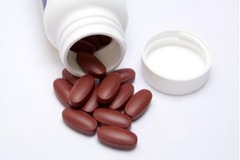Female athletes are twice as likely to develop iron deficiencies as non-active individuals. There are likely several factors contributing to this phenomenon. The increased prevalence of iron deficiency in active women may be due to one or a combination of the following factors: the destruction of iron-containing red blood cells associated with repeated high impact foot strike (often seen in endurance runners); increased iron losses (via the gastrointestinal tract, urine, and sweat); poor dietary iron intake (often a result of athletes dieting to lose weight); or altered intestinal absorption of iron, including the effects of inflammation due to training. The routine use of NSAIDs (nonsteroidal anti-inflammatory drugs) such as ibuprofen, may also contribute to iron deficiency in this population.
Iron deficiency can negatively affect athletic performance even before it causes anemia. Because of this, female athletes require higher cut off points in laboratory tests to identify significant deficiencies in iron. Hemoglobin (Hgb) and serum Ferritin cut-offs of 12 g/dL and 30 ng/mL, respectively, should be used to identify iron deficiency in female athletes before it leads to anemia. Since these values are considered within normal limits for by most labs, many primary care doctors will likely miss this and fail to recommend iron supplements to female athletes. Research suggests that athletes with identified iron deficiencies (with or without anemia) should be provided with appropriate treatment that includes a low-moderate dose of supplemental iron (Fe), 100 mg of FeSO4 per day, and/or nutrition counseling. Choosing a slow release type of iron supplement can decrease the risk of constipation that is sometimes associated with taking iron supplements.  Nutrition therapy provided by a registered dietitian can help athletes learn how to increase dietary intake and improve the bioavailability of dietary iron. Athletes, coaches, trainers and healthcare professionals should be aware that iron status as well as dietary and supplement compliance of iron deficient athletes should be monitored regularly throughout training seasons to ensure sufficient dietary intakes of iron, and to prevent subsequent dips in Fe status associated with training. The good news is that proper iron supplementation can correct iron deficiencies and improve athletic performance.
Nutrition therapy provided by a registered dietitian can help athletes learn how to increase dietary intake and improve the bioavailability of dietary iron. Athletes, coaches, trainers and healthcare professionals should be aware that iron status as well as dietary and supplement compliance of iron deficient athletes should be monitored regularly throughout training seasons to ensure sufficient dietary intakes of iron, and to prevent subsequent dips in Fe status associated with training. The good news is that proper iron supplementation can correct iron deficiencies and improve athletic performance.
Reference:
- DellaValle, D.M. PhD, RD; Iron Supplementation for Female Athletes: Effects on Iron Status and Performance Outcomes. Current Sports Medicine Reports: July/August 2013 – Volume 12 – Issue 4 – p 234-239
- Pitsis, Clin J Sport Med. 2004
- Fallon, KE. Utility of hematological and iron-related screening in elite athletes. Clin J Sport Med 2004;14(3):145-152


